|
The following manual describes the creation of audiobooks (*. m4b) for compatible players such as Apple's iPod by using AAC files (*.m4a).
|
| Basic settings |
|
 since Version 2.0:
since Version 2.0:
When using
 "neroAacEnc.exe"
the conversion of AAC files can be made with the AAC Audiobook Creator directly. For that, use "neroAacEnc.exe"
the conversion of AAC files can be made with the AAC Audiobook Creator directly. For that, use
 "Preferences"
to specify the desired data rate, the encoding mode, the AAC profile (all since Version 2.1), the audio channel mode and sample rate (both since Version 3.0) as well as to determine the maximum possible number of parallel threads as shown below. "Preferences"
to specify the desired data rate, the encoding mode, the AAC profile (all since Version 2.1), the audio channel mode and sample rate (both since Version 3.0) as well as to determine the maximum possible number of parallel threads as shown below.
Notes:
- The maximum number of parallel threads corresponds with the number of (logical) processor cores.
- Large MP3 files use much disk space during the temporary conversion into WAV files. In this case, reduce the number of parallel executions.
- In case of very many small MP3 files increase the number of parallel executions for maximum conversion speed.
- In case of exclusive use of AAC files as starting material, the number of possible parallel executions has no influence on the achievable creation speed.

AAC Encoding Settings (since Version 2.2)
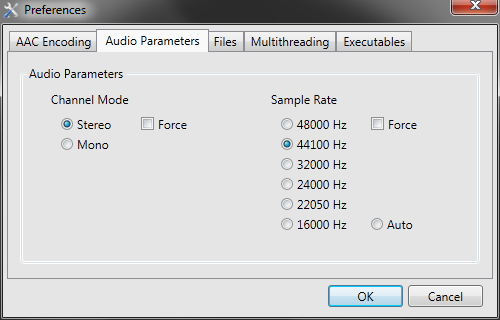
Audio Parameter Settings (since Version 3.0)

(Temporarily) Encoded AAC Files Setting (since Version 2.2) and Project Settings (since Version 3.0)
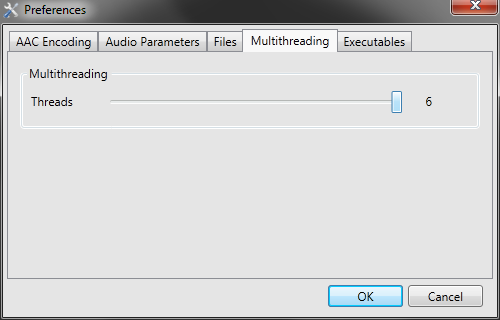
Maximum Number of Parallel Threads Setting (since Version 2.0)
|
|
| Creating a project folder |
|
In order to do not lose track for an increasing number of audiobook projects, it is recommended to create for each project a separate directory first.
The following structure was chosen for the example used in this manual:
- Drive
- Directory "Quellen"
- Directory Artist Name
- Directory Audiobook Name
- Directory "M4A"
- Directory "MP3"
- File Audiobook Name.xod (this is the project file)
- File "Cover.jpg" (this is the audiobook cover)

Project Directory Structure
In this specific example, this means that the project directory "6 Minute English" is located at drive "v:\", in a folder "Quellen", witch includes the author directory "BBC".
The author directory includes (as well as any other project directory) a folder "M4A" for the new created AAC files as well as a folder "MP3" for the original files.
In the figure above a file "6 Minute English" of type "AAC Audio Book Creator" (*.xod) can be seen that contains all necessary data for the creation of the audiobook in an XML format. This file is
generated by the program when the user saves the project. Finally a file "Cover.jpg" can be found, which, as its name suggests, includes the cover of the audiobook.
|
|
| Adjusting iTunes preferences (only necessary when an Audiobook Creator version < 2.0 is used) |
|
 since Version 2.0:
since Version 2.0:
When using
 "neroAacEnc.exe"
the method described below is no longer necessary. "neroAacEnc.exe"
the method described below is no longer necessary.
Before the required AAC files can be created from their respective starting material, the import settings of the conversion task should be checked and adjusted first, as necessary.
The preferences dialog from iTunes is located at
"Edit" >> "Preferences..."
(faster by using <Ctrl> + ,).

iTunes Preferences Dialog
After clicking "Import Settings ..." a dialog opens in which the desired encoder and the appropriate settings can be selected.
|
|
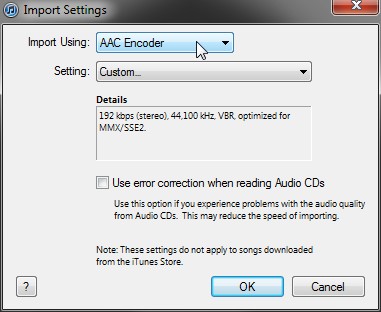
Import Settings
First, the entry "AAC Encoder" has to be chosen from the drop down list "Import Using".
|
|
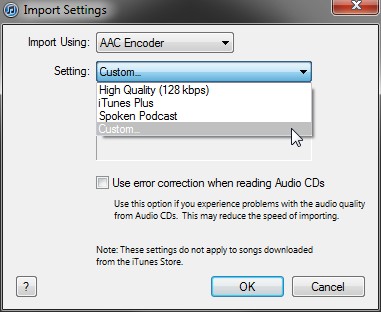
Import Settings: "Custom..."
In the second step, the entry "Custom..." has to be chosen from the drop down list "Setting"...
|
|
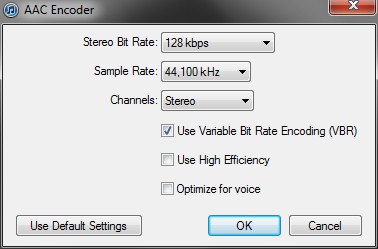
AAC Encoder Settings
... whereupon the settings dialog of the AAC encoder opens.
It should be noted while choosing the desired settings, that all chapter files in an audiobook have to be both, of the same sample rate (typically 44.1 kHz)
as well as the same number of channels (mono or stereo). On the other hand, the selected data rate may vary especially in case of coding with variable bit rate,
as the name already suggests.
Note:
- should iTunes or the iPod not accept a newly compiled audiobook, the cause is usually found in a violation of this rule
|
|